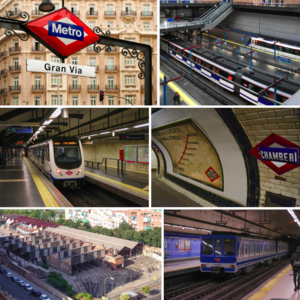
Back Metro de Madrit AN مترو مدريد Arabic مترو مدريد ARZ Мадрыдскі метрапалітэн Byelorussian Мадрыдзкі мэтрапалітэн BE-X-OLD Мадридско метро Bulgarian মাদ্রিদ মেট্রো Bengali/Bangla Metro de Madrid Catalan Metro v Madridu Czech Madrid Metro Danish
You can help expand this article with text translated from the corresponding article in Spanish. (February 2023) Click [show] for important translation instructions.
|
| Madrid Metro | |||
|---|---|---|---|
 | |||
 | |||
| Overview | |||
| Native name | Metro de Madrid | ||
| Owner | Autonomous Government of the Community of Madrid | ||
| Locale | Madrid, Spain | ||
| Transit type | Rapid transit | ||
| Number of lines | 13[1] | ||
| Number of stations | 276[2][n. 1] | ||
| Daily ridership | 2.4 million | ||
| Annual ridership | 662,3 million (2023)[3] | ||
| Website | Metro de Madrid | ||
| Operation | |||
| Began operation | 17 October 1919 | ||
| Operator(s) | Metro de Madrid | ||
| Number of vehicles | ~2400[4] | ||
| Technical | |||
| System length | 293.0 km (182.1 mi)[1] | ||
| Track gauge | 1,445 mm (4 ft 8+7⁄8 in) (Lines 1–12, R) 1,435 mm (4 ft 8+1⁄2 in) standard gauge (Metro Ligero) | ||
| Electrification | 600 V DC overhead lines (Lines 1, 4, 5, 6, 9) 750 V DC overhead lines (Metro Ligero) 1,500 V DC overhead lines (all other lines) | ||
| |||
The Madrid Metro (Spanish: Metro de Madrid) is a rapid transit system serving the city of Madrid, capital of Spain. The system is the 14th longest rapid transit system in the world, with a total length of 293 km (182 mi). Its growth between 1995 and 2007 put it among the fastest-growing networks in the world at the time. However, the European debt crisis greatly slowed expansion plans, with many projects being postponed and canceled. Unlike normal Spanish road and rail traffic, which drive on the right, Madrid Metro trains use left-hand running on all lines because traffic in Madrid drove on the left until 1924, five years after the system started operating.
Trains are in circulation every day from 6:00 am until 1:30 am,[5] though during the weekends, this schedule is to be extended by one more hour in the morning in 2020. Furthermore, the regional government intends to keep stations opened around the clock during these days from 2023 onwards.[6][7] It has only stayed open 24 hours during the 2017 World Pride and during the 2021 Madrid snowstorm.[8]
A light rail system feeding the metro opened in 2007 called Metro Ligero ("light metro").[9] The Cercanías system works in conjunction with the metro, with a majority of its stations providing access to the underground network.
As of January 2024, the Madrid Metro has 1,710 escalators and 559 elevators.[10]
- ^ a b "Metro de Madrid Figures". Metro de Madrid. Archived from the original on 16 October 2017. Retrieved 30 July 2019.
- ^ "Informe Corporativo 2020 Metro de Madrid" (PDF). Metro de Madrid. 2021. Retrieved 6 June 2020.
- ^ [1] (in Spain)
- ^ "Metro de Madrid en cifras – Metro de Madrid". Metro de Madrid. Retrieved 30 July 2019.
- ^ "Public transport in Madrid in Spain: spain.info in english". Spain.info. Retrieved 18 August 2016.
- ^ "La Comunidad inicia los trámites para abrir el Metro 24 horas los fines de semana" (in European Spanish). La Razón. 9 September 2019. Retrieved 9 September 2019.
- ^ "Metro de Madrid abrirá hasta las 2.30 horas los fines de semana en 2020" (in Spanish). El Mundo. 29 October 2019. Retrieved 30 October 2019.
- ^ Belver, Marta (11 January 2021). "El reto inédito del Metro de Madrid debido al temporal: más de 100 horas de servicio ininterrumpido". El Mundo.
- ^ Von Mach, Stefan (March 2008). "Madrid Light Rail: Three lines to feed the metro". Metro Report International, of Railway Gazette International (UK).
- ^ "Metro de Madrid en cifras". Metro de Madrid. 1 August 2019. Retrieved 18 March 2024.
Cite error: There are <ref group=n.> tags on this page, but the references will not show without a {{reflist|group=n.}} template (see the help page).
